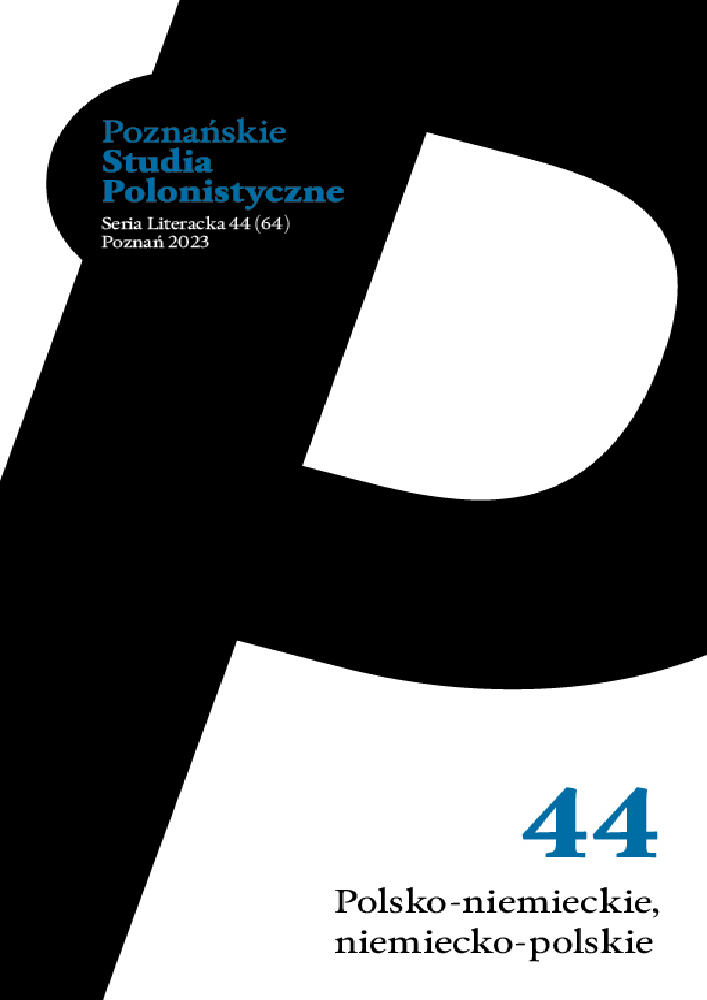Abstract
The article is devoted to the first three volumes of Michael Meinert’s Hochwald-Saga (The High Forest Saga) series, whose action takes place in Silesia in the 19th century; these are are: Gescheiterte Flucht (Failed Escape), Der zerrissene Graf (Lost count) and Ehrlicher Schwindler (Honest swindler). In these works, the author breaks away from the stereotypical perception of Silesia as a space of memory, the critical turning point of which was the end of World War II. He does not create images of a “lost homeland” – Silesia becomes an attractive historical space for him precisely because of its past character, and is a fascinating setting for novels with historical plots. At the same time, he revives the history of Silesia as a province of the Kingdom of Prussia and later of the German Empire. He also creates images of space, assigning them additional meanings, which is in line with the idea of space semantisation promoted by Yuri Lotman. An extremely important element in the composition of Meinert’s works is the creation of Silesia as a sacred space in which existential, axiological and theological questions are asked. In his understanding, places become a humanised space which has its own characteristic identity and often depicts the emotional states or character traits of the novel’s figures; moreover, it plays an important role in shaping their attitudes and values. The purpose of this text is to analyse the poetics of Meinert’s above-mentioned novels with particular emphasis on the topos of Silesia, its characteristics, and the role and functions it plays in them. As it is closely related to the poetics of place, attention is also paid to selected aspects of geopoetics in the sense proposed by Elżbieta Rybicka.
References
Genette Gérard (1998), Die Erzählung, przeł. A. Knop, Wilhelm Fink, Monachium.
Genette Gérard (2001), Paratexte. Das Buch vom Beiwerk des Buches, przeł. D. Hornig, Suhrkamp, Berlin.
Jasińska-Wojtkowska Maria, Dybciak Krzysztof, red. (1993), Proza polska w kręgu religijnych inspiracji, KUL, Lublin.
Łotman Jurij (1984), Struktura tekstu artystycznego, przeł. Anna Tanalska, PIW, Warszawa.
Meinert Michael (2012), Gescheiterte Flucht, BOAS, Burbach.
Meinert Michael (2014), Der zerrissene Graf, BOAS, Burbach.
Meinert Michael (2015), Ehrlicher Schwindler, BOAS, Burbach.
Meinert Michael (2018), Interview mit Michael Meinert, rozm. przepr. Nicole Katharina Timm, https://tinyurl.com/bddknht8 [dostęp: 25 maja 2022].
Meinert Michael (2022), Herzlich willkommen, http://www.michael-meinert.eu/ [dostęp: 9 maja 2022].
Papuzińska Joanna, Leszczyński Grzegorz, red. (1998), Dzieciństwo i sacrum. Studia i szkice literackie, Stowarzyszenie Przyjaciół Książki dla Młodych – Polska Sekcja IBBY, Warszawa.
Papuzińska Joanna, Leszczyński Grzegorz, red. (2000), Dzieciństwo i sacrum 2. Studia i szkice literackie, Stowarzyszenie Przyjaciół Książki dla Młodych – Polska Sekcja IBBY, Warszawa.
Rybicka Elżbieta (2014), Geopoetyka. Związki literatury i środowiska, Universitas, Kraków.
Skotnicka Gertruda (2000), O „Lecie leśnych ludzi” Marii Rodziewiczówny, w: Dzieciństwo i sacrum 2. Studia i szkice literackie, red. Joanna Papuzińska, Grzegorz Leszczyński, Stowarzyszenie Przyjaciół Książki dla Młodych – Polska Sekcja IBBY, Warszawa, s. 13–30.
Tarnowski Janusz (1998), Spotkanie dziecka ze światem sacrum, w: Dzieciństwo i sacrum. Studia i szkice literackie, red. Joanna Papuzińska, Grzegorz Leszczyński, Stowarzyszenie Przyjaciół Książki dla Młodych – Polska Sekcja IBBY, Warszawa, s. 17–24.
Wójcicka Edyta (2020), Przestrzeń literacka jako nośnik wartości w perspektywie edukacyjnej na przykładzie powieści J.R.R. Tolkiena „Hobbit, czyli tam i z powrotem”, „Studia Edukacyjne”, nr 59, s. 285–310,
License
Copyright (c) 2023 Marta Ratajczak

This work is licensed under a Creative Commons Attribution-NoDerivatives 4.0 International License.
Authors
Authors of texts accepted for publication in „Poznańskie Studia Polonistyczne. Seria Literacka” are required to complete, sign and return to the editor's office the Agreement for granting a royalty-free license to works with a commitment to grant a CC sub-license.
Under the agreement, the authors of texts published in „Poznańskie Studia Polonistyczne. Seria Literacka” grant the Adam Mickiewicz University in Poznań a non-exclusive, royalty-free license and authorize the use of Attribution-NoDerivatives 4.0 International (CC BY-ND 4.0)Creative Commons sub-license.
The authors retain the right to continue the free disposal of the work.
Users
Interested Internet users are entitled to use works published in „Poznańskie Studia Polonistyczne. Seria Literacka” since 2016, for non-commercial purposes only, under the following conditions:
- attribution - obligation to provide, together with the distributed work, information about the authorship, title, source (link to the original work, DOI) and the license itself.
- no derivatives - the work must be preserved in its original form, without the author's consent it is not possible to distribute the modified work, such as translations, publications, etc.
Copyrights are reserved for all texts published before 2016.
Miscellaneous
Adam Mickiewicz University in Poznań retains the right to magazines as a whole (layout, graphic form, title, cover design, logo etc.).

